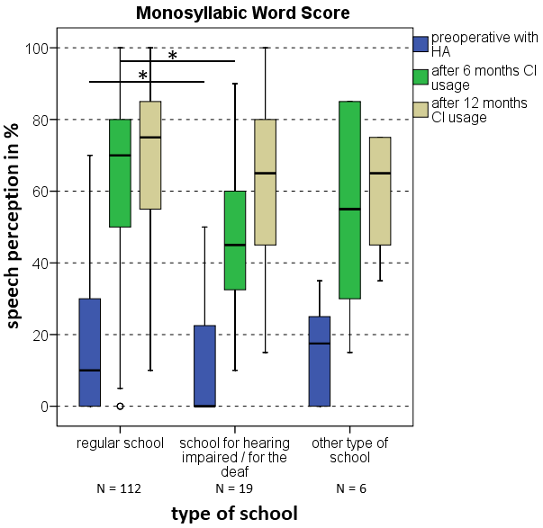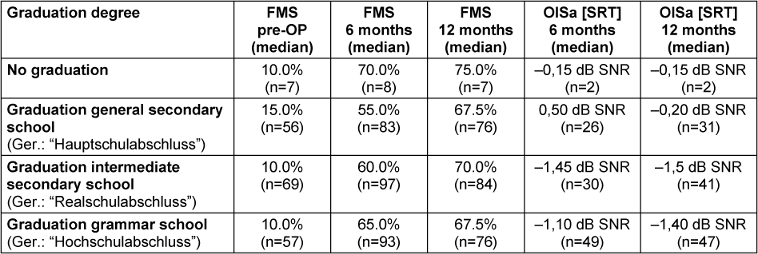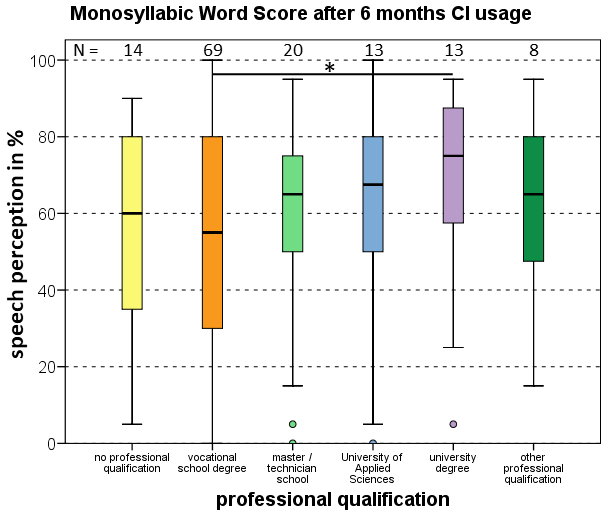[Factors influencing speech perception after CI treatment: Does the patient’s level of education have an influence on the CI outcome?]
Stefanie Bruschke 1Christoph Broeder 1
Uwe Baumann 1
1 Goethe University Frankfurt, University Hospital, ENT Department, Audiological Acoustics, Frankfurt a. M., Germany
Abstract
The postoperative hearing performance that can be achieved with a cochlear implant (CI) is very individual and depends on many factors. These include the etiology, such as cause of deafness and duration of auditory deprivation, as well as the daily processor usage. These factors have already been investigated. It can be assumed that there are other factors that can contribute to hearing success with a CI. To date, there have only been a few studies on the extent to which socio-economic factors influence hearing success with a CI. The aim of the present study was to investigate the influence of the level of education of CI users on postoperative speech perception.
In total, 326 patients with a mean age of 58.6 years (min/max 20.2/92.2 years) were included in the study. The data collection was retrospective in the period of November 2021 to December 2022. A “Work and Life” questionnaire specially developed for clinical routine was used for evaluation of different socio-economic parameters. Within the questionnaire, the level of education of the patients was documented, including the type of school attended, as well as the educational and professional qualifications of the patients. In addition, the preoperative monosyllabic speech perception with hearing aids was evaluated. Furthermore, postoperative speech perception after 6 and 12 months CI experience measured with the Freiburg monosyllabic word test and the Oldenburg Sentence Test (OlSa) was documented.
The results showed a significant difference of outcome depending on the types of school. Patients, who attended regular school showed a better speech perception in quiet in pre- and postoperative results, than patients who attended a school for hearing impaired/for the deaf. There was also a difference in the results regarding the professional qualification. Patients with a university degree showed a better postoperative speech perception in quiet than patients with a vocational school degree. The results showed no differences between the graduation degrees of the CI users.
Clinical routine has shown that the hearing performance with the CI is very individual. Many factors need to be taken into account when predicting the postoperative hearing success. Socio-economic factors may have an influence on the hearing performance with the CI.
Keywords
cochlear implant, CI outcome, socio-economic factors, level of education, speech perception
1 Introduction
The cochlear implant (CI) is a standard treatment for patients with severe to profound hearing loss and complete deafness [1], [2]. A CI treatment can improve patients’ speech perception and quality of life [3], [4]. The postoperative hearing performance that can be achieved with a CI is very individual and depends on many factors [2]. These include the etiology, such as the cause of deafness and duration of auditory deprivation, as well as the daily CI processor usage. These factors have already been investigated [5], [6], [7]. It can be assumed that there are other factors that may influence the hearing outcome with the CI. To date, there have only been a few studies on the extent to which socio-economic factors have an influence on hearing success with a CI.
The aim of this study was to investigate the influence of the level of education of CI users on postoperative speech perception.
1.1 Material and method
The study was performed retrospectively in the period from November 2021 to December 2022 (study approval by the local Ethics Committee of the Department of Medicine at the University of Frankfurt, case number 2022-642). In total, 326 adult CI patients (190 f/136 m) were included in the data analysis. The mean age of the patients was 58.6 years (min. 20.2 years/max. 92.2 years).
A questionnaire regarding “Work and Life”, specially developed for clinical routine was used for data collection. This is regularly handed out to patients as part of the preliminary examination for CI treatment. This questionnaire aims to record various socio-economic parameters, including the patient’s level of education. As part of the data analysis, the type of school attended and the educational and professional qualifications of the CI users were considered. Furthermore, preoperative speech perception with hearing aids and postoperative speech perception with CI after 6 and 12 months of CI use were evaluated. Speech perception in quiet was measured using the Freiburg monosyllabic test [8] at 65 dB SPL in free field. Furthermore, speech perception in noise was measured using the Oldenburg sentence test (OlSa) [9] at a fixed speech level of 65 dB SPL and an adaptive noise level. The measurement was carried out in free field with speech and noise signal from the front (S0N0).
For statistical analysis, the data was tested for normal distribution using the Kolmogorov-Smirnov test. Since there was no normal distribution, a pairwise comparison was carried out using the Mann-Whitney U test (MWU). A significance level of 0.05 was defined.
2 Results
2.1 Type of school
The evaluation of the hearing performance of CI users with regard to the type of school showed that patients who attended a regular school had significantly better (pre OP: ZMWU=–2.506, pMWU=0.036/6M: ZMWU=–2.726, pMWU=0.018) monosyllabic speech perception both preoperatively and after 6 months of CI experience (pre OP: 10%/6M: 65%) than patients who attended a school for the hearing impaired/for the deaf (pre OP: 0%/6M: 50%; see Figure 1 [Fig. 1]). For the speech perception in noise (OlSa), on the other hand, there was no difference in pre- and postoperative hearing performance between the types of school (regular school: 6M: –1.0 dB SNR/12M: –1.4 dB SNR; school for the hearing impaired/for the deaf: 6M: 0.25 dB SNR/12M: 0.4 dB SNR).
Figure 1: Monosyllabic speech perception of CI users for the respective type of school attended (regular school, school for the hearing impaired/for the deaf, other type of school) at different measurement times: blue: preoperative with hearing aid (HA), green: postoperative after 6 months of CI use, yellow: postoperative after 12 months of CI use; *p<0.05
2.2 Graduation degree
The results regarding the CI users’ graduation degree after attending school showed comparable pre- and postoperative speech perception in quiet and in noise (see Table 1 [Tab. 1]). There was no significant difference (p>0.05) between the different graduation degrees, meaning that speech perception with the CI was independent of the quality of the graduation degree. The patient group without a graduation degree after attending school achieved comparable results to patients with a graduation degree.
Table 1: Speech perception in quiet (Freiburg Monosyllabic Word Score, FMS) and in noise (OlSa) for the respective graduation degree of the CI users
2.3 Professional qualification
The data analysis regarding the professional qualification of the CI users showed that patients with a university degree had significantly (ZMWU=–2.887, pMWU=0.04) better postoperative speech perception in quiet than patients with a vocational school degree (university degree: 75%/vocational school degree: 55%, see Figure 2 [Fig. 2]). No significant difference in speech perception in noise was found between the different professional qualifications. Furthermore, patients without a professional qualification showed comparable speech perception to patients with a professional qualification.
Figure 2: Postoperative monosyllabic speech perception of the CI users after 6 months of CI use for the respective professional qualifications (yellow: no professional qualification, orange: vocational school degree, light green: master/technician school, blue: University of Applied Sciences, purple: university degree, dark green: other professional qualification), *p<0.05
3 Discussion
Clinical routine has shown that the hearing success with the CI is very individual. Many factors need to be taken into account when predicting the postoperative hearing success. In particular, the influence of socio-economic factors has not been further investigated. The study results were able to show that the type of school attended and the professional qualification as socio-economic factors can have an influence on the postoperative hearing performance with the CI.
When interpreting the results, it should be noted that there are probably differences in the type of communication between schools for the hearing impaired/for the deaf and regular schools. Patients who attended a school for the hearing impaired/for the deaf may have a different approach to speech material than patients who attended a regular school. As a result, the test material of the Freiburg monosyllabic test may be less familiar or not familiar at all. Patients with a university degree showed better postoperative speech perception than patients with a vocational school degree. It can be assumed that CI users with a higher level of education have easier access to speech material/training material or may have learned better to acquire knowledge themselves and are therefore more motivated to perform individual auditory training. This could then have an effect on postoperative hearing performance with the CI. Furthermore, the wide age range of the patients from 20 to 92 years must be taken into account when interpreting the study results. It can be assumed that the weighting of education has changed over time, especially for women. In addition, the test material of the Freiburg monosyllabic test is outdated and may not be familiar to younger patients. Therefore, a bias in the results cannot be excluded. Furthermore, it should be noted that the CI users had different etiologies. A bias in the speech test results is possible, particularly with regard to the duration of auditory deprivation.
3.1 Conclusion
Socio-economic parameters as factors influencing postoperative hearing performance with the CI have been little investigated to date. The aim of future studies may be to investigate further socio-economic factors that influence individual hearing performance with the CI.
Notes
Conference presentation
This contribution was presented at the 26th Annual Conference of the German Society of Audiology and published as an abstract [10].
Competing interests
The authors declare that they have no competing interests.
References
[1] Hoppe U, Liebscher T, Hornung J. Anpassung von Cochleaimplantatsystemen [Cochlear implant fitting strategies]. HNO. 2017 Jul;65(7):546-51. DOI: 10.1007/s00106-016-0226-7[2] Lenarz T. Cochlear Implant – State of the Art. Laryngorhinootologie. 2017 Apr;96(S 01):S123-S151. DOI: 10.1055/s-0043-101812
[3] Sun CH, Chang CJ, Hsu CJ, Wu HP. Feasibility of early activation after cochlear implantation. Clin Otolaryngol. 2019 Nov;44(6):1004-10. DOI: 10.1111/coa.13427
[4] Rader T, Haerterich M, Ernst BP, Stöver T, Strieth S. Lebensqualität und Schwindel bei bilateraler Cochleaimplantation: Fragebogeninstrumente zur Qualitätssicherung [Quality of life and vertigo after bilateral cochlear implantation: Questionnaires as tools for quality assurance]. HNO. 2018 Mar;66(3):219-28. DOI: 10.1007/s00106-017-0456-3
[5] Janeschik S, Teschendorf M, Bagus H, Arweiler-Harbeck D. Influence of etiologic factors on speech perception of cochlear-implanted children. Cochlear Implants Int. 2013 Sep;14(4):190-9. DOI: 10.1179/1754762812Y.0000000017
[6] Bernhard N, Gauger U, Romo Ventura E, Uecker FC, Olze H, Knopke S, Hänsel T, Coordes A. Duration of deafness impacts auditory performance after cochlear implantation: A meta-analysis. Laryngoscope Investig Otolaryngol. 2021 Apr;6(2):291-301. DOI: 10.1002/lio2.528
[7] Craddock L, Cooper H, Riley A, Wright T. Cochlear implants for pre-lingually profoundly deaf adults. Cochlear Implants Int. 2016 Apr;17(Suppl 1):26-30. DOI: 10.1080/14670100.2016.1161122
[8] Hahlbrock KH. Über Sprachaudiometrie und neue Wörterteste [Speech audiometry and new word-tests]. Arch Ohren Nasen Kehlkopfheilkd. 1953;162(5):394-431.
[9] Wagener K, Kühnel V, Kollmeier B. Entwicklung und Evaluation eines Satztests für die deutsche Sprache. I: Design des Oldenburger Satztests. Z Audiol. 1999;38(1):4-15.
[10] Bruschke S, Broeder C, Baumann U. Einflussfaktoren auf das Sprachverstehen nach CI-Versorgung: Hat der Bildungsgrad der Patienten einen Einfluss auf das CI-Outcome? In: Deutsche Gesellschaft für Audiologie e.V., editor. 26. Jahrestagung der Deutschen Gesellschaft für Audiologie. Aalen, 06.-08.03.2024. Düsseldorf: German Medical Science GMS Publishing House; 2024. Doc162. DOI: 10.3205/24dga162




